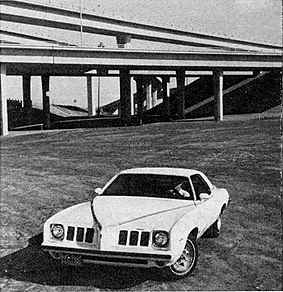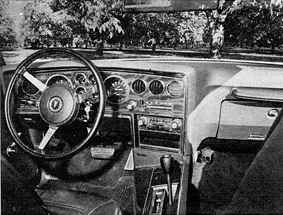|
Once purchased, owners began to discover what they'd gotten. "Very comfortable, especially on trips." "Cruises effortlessly, rides surprisingly well on silent radial tires." "I like the standard features such as disc brakes, steel-belted radial tires, reclining bucket seats, the smooth handling and quick response." "I drive an average of 60,000 miles a year, and this is the best road car I've ever had." "Corners best of any car I've ever driven."
|
An Albuquerque jeweler compared his Grand Am to the 1968 Mercedes 280SE sedan he'd traded in on it. "I'll never understand the Mercedes' shortcomings. It's superbly designed and the engineering is faultless. But it was always noisy (engine and wind) and too expensive to maintain. When we traded it at 42,000 miles, it needed an engine overhaul, used a quart of oil every 300 miles, and chugged at idle (cure: a $400 injector pump).
NEXT >
(Please turn to page 52B)
|
|

DISTINCTIVE FRONT sets Grand Am apart from other Pontiac intermediates, but rear looks like Le Mans

DRIVER-ORIENTED COCKPIT sets full gauges in real mahogany dash. Turbo Hydra-Matic trans is standard
|
What makes this American gran turismo car European?
THE AUTOMAKERS' DREAM is sports-car handling in a family sedan. The Europeans got there first: Jaguar, Mercedes, Citroen, BMW and so on.
Not to be outdone, GM decided that if the Europeans can do it, so can we. GM set out to build—and did build—four cars that embody true gran turismo handling, maneuverability, braking and performance, combined with a good long-distance ride, roominess, general comfort and luxury.
For 1973, all four of GM'-s A-bodied intermediates—Pontiac Grand Am, Chevy Monte Carlo, Olds Cutlass Salon and Buick Regal—offer true GT models. These cars really handle. Let's see what makes Grand Am that way.
The Grand Am's chassis was set up specifically for steel-belted radial tires. (See How Detroit is "tuning" its new cars for radials, which begins on page 130.) Suspension uses heavy-duty everything, including harder rubber bushings, a thicker front stabilizer (1.12 in. o.d.), a standard rear stabilizer and a bit more suspension travel than found in normal Pontiac intermediates.
Shock absorbers, called Pliacell, have internal plastic membranes that separate the hydraulic fluid from the gas. At high speeds on rough roads, most shocks tend to aerate (gas and fluid mix, causing bubbles). This kills a shock's effectiveness. But Pliacell shocks can't aerate.
Despite a much stiffer-than-normal suspension, the Grand Am's ride is very smooth and silent—surprisingly so. At 80 mph, the car feels like most others doing 60.
Two V8s in four horsepower ratings lend impressive performance. Hottest is the LS2 Super Duty 455-cu.-in. V8 at 310 hp net. This engine has fittings at the back of the block for quick conversion to dry-sump lubrication (for racing). Transmission choices include the Muncie M21 wide-ratio four-speed or GM's Turbo Hydra-Matic (standard).
Conclusion: If you want a car that handles—and one that handles the family as well—the Grand Am and its three A-bodied cousins will give you more grand touring for your money than anything from Europe.—M.L. < BACK to page 1
|
| 52 |
POPULAR MECHANICS |
|